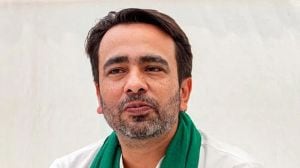Why Sri Lanka’s newly elected President dissolved Parliament
Sri Lanka’s 225-member Parliament has a term of five years. The previous election took place in August 2020, which means the now-dissolved Parliament was supposed to be in place until August 2025. Why was it dissolved? We explain
 Anura Kumara Dissanayake addresses a gathering after taking his oath of office at the Presidential Secretariat, in Colombo, Sri Lanka, September 23, 2024. (Photo: Reuters)
Anura Kumara Dissanayake addresses a gathering after taking his oath of office at the Presidential Secretariat, in Colombo, Sri Lanka, September 23, 2024. (Photo: Reuters)A day after assuming office, Sri Lanka’s President Anura Kumara Dissanayake on Tuesday dissolved Parliament and announced a snap election on November 14.
Dissanayake had indicated during the campaign that upon coming to power, he would seek a fresh mandate to pursue his policies. There is “no point continuing with a Parliament that is not in line with what the people want,” he had said, according to media reports.
Political situation
Sri Lanka’s 225-member Parliament has a term of five years. The previous election took place in August 2020, which means the now-dissolved Parliament was supposed to be in place until August 2025.
However, the socialist National People’s Power (NPP) alliance led by Dissanayake and his Janatha Vimukthi Peramuna (JVP) party, had just three seats in this Parliament. This is because until 2022, the NPP largely remained on the fringes of Sri Lankan politics.
The meteoric rise of the NPP, exemplified by the mandate received by Dissanayake in Saturday’s presidential election, came on the back of the mass protests that rocked Sri Lanka in 2022. The NPP led the street agitation against years of economic mismanagement and corruption — protests that forced the powerful Rajapaksa family from power and compelled President Gotabaya Rajapaksa to flee the country.
Ranil Wickremesinghe, who became President in July 2022, was backed in Parliament by the Rajapaksas’ Sri Lanka Podujana Peramuna (SLPP) party.
In the backdrop of this situation, it was always likely that if he were to come to power, Dissanayake would dissolve Parliament and call fresh elections, in which the NPP would likely make major gains.
Sri Lankan system
Technically, the President and Prime Minister can be from different political parties. But in reality, ever since the President was given executive powers in 1978, the two offices have been closely aligned. This is because for all practical purposes, the Prime Minister acts as deputy to the President in Sri Lanka.
The President is both the head of state and head of government, as well as the commander-in-chief of the Sri Lankan armed forces, and the head of the Union cabinet. The President has the power to dissolve Parliament. The President is directly elected for a six-year term.
The Prime Minister is the most senior member of Parliament and the Union cabinet, and the chief adviser to the President. The PM is also the first in line to succeed the President. Wickremesinghe was PM when Gotabaya was President.
What happens now
Hours before Dissanayake took oath as President on Monday, Dinesh Gunawardene resigned as Prime Minister. On Tuesday, Dissanayake appointed Harini Amarasuriya, one of the three NPP members of Parliament, as Prime Minister. Amarasuriya will head the Union cabinet, which will act as the interim government until elections take place in November. A new PM will be appointed after that.
Photos



- 01
- 02
- 03
- 04
- 05


































